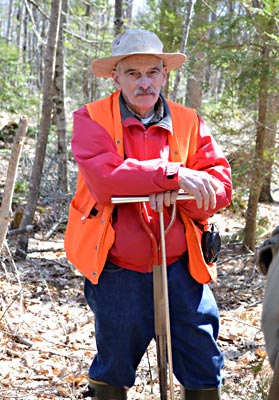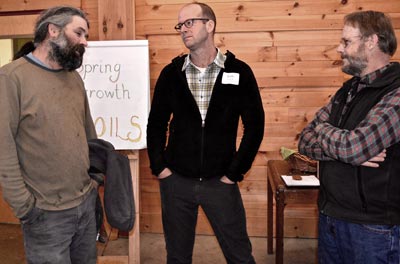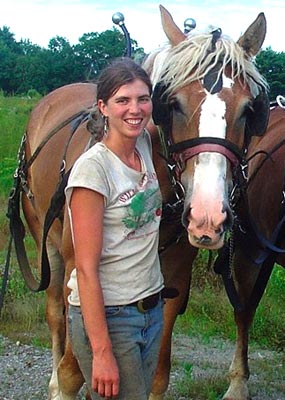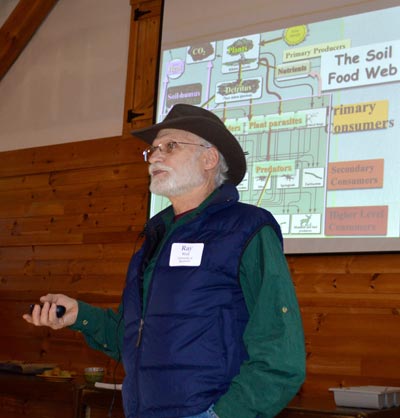 |
| David Rocque. English photo |
MOFGA’s 2016 Spring Growth Conference addressed soils, with experts from the state of Maine, from two state universities and from three MOFGA-certified organic farms.
David Rocque, Maine Department of Agriculture, Conservation and Forestry soil scientist, defined “soils,” talked about soil-forming factors – especially parent materials – and about identifying soil types with the Web Soil Survey (https://websoilsurvey.sc.egov.usda.gov/App/HomePage.htm). He can visit and evaluate sites himself for their farming potential.
“Beginning farmers often focus on a soil test,” said Rocque. “I think the potential of your soil is far more important. You can always take a high potential soil with a poor soil test and build it up, but it is hard to take a soil with low potential (e.g., shallow to bedrock, poorly drained) and a good soil test and improve its potential.”
He stressed the importance of knowing the soil types on your land, especially if you want to expand or create a field. With forest land, too, know where to spend valuable time and resources to get as much return as possible, said Rocque.
He emphasized the value of improving soil structure by adding organic matter (OM). Other improvements may include draining with tile or ditching; plowing swales and farming on the bumps; subsoiling; removing rocks (“but they mostly grow back again,” said Rocque); terracing; growing certain plants to remove excess nutrients; growing plants that are adapted to certain soils; and adding amendments, such as lime to raise the pH. Once good soil structure is achieved, maintain it by minimizing compaction, erosion, depletion, stripping topsoil, filling with the wrong material, flooding and pollution.
New Insights into Soil Organic Matter
Tim Bowles, a postdoctoral student at the University of New Hampshire, contrasted passive soil organic matter (SOM), which isn’t very active biologically but contributes considerably to cation exchange capacity (CEC) and to soil physical structure, with more biologically active SOM pools – those most diminished by cultivation, erosion, monocultures and other simplified activities.
Bowles said organic plots at the Century Experiment at the University of California, Davis, have accumulated substantially more soil organic C (SOC) in a corn-tomato rotation with a vetch cover crop and manure than have conventional plots using the same rotation and synthetic fertilizers. The organic system has had twice as much C input but has accumulated C 14 times faster than the conventional system.
Likewise, SOC in the Kellogg Biological Station Long-Term Ecological Research Program in Michigan is about 15 percent higher in an organic corn-soy-wheat rotation grown with a rye-clover cover crop than in a conventional system – even though the organic system had lower total C inputs.
 |
| Tim Bowles. Photo courtesy of Tim Bowles |
One potential reason for higher SOC in these organic systems is that much of the SOC that is stabilized in soil has been processed through soil microbes. Microbes’ efficiency at consuming SOM – the proportion of C incorporated into new biomass versus CO2 respired – depends on the quality of OM, the type of microbe (e.g., fungi vs. bacteria), environmental and other factors. Thus, greater efficiency means that microbial biomass will contribute more stabilized SOM. A study in Michigan by Kallenbach et al., 2015, found that microbes in an organic system respired less CO2 per unit of C consumed than in a conventional system, and more C inputs were retained after one year. The initial increase in microbial biomass in the organic system declines as that same C accumulates in the bulk soil and in clay microaggregates, said Bowles. Still, soil C may accumulate to a greater extent in organic systems because of the quality of that C and how microbes process it.
To increase SOM, Bowles said to minimize losses by preventing erosion, reducing tillage (sometimes difficult in organic systems), increasing cover cropping and crop rotations, intercropping, integrating animals into the system (to move C from the pasture or grain grown on the farm to an arable field), adding manure and compost, and by paying attention to roots. Carbon coming from roots tends to be more stabilized in SOM than plant matter left on the surface for tilling.
Increased crop diversity strongly affects soil and microbes over time because it diversifies the type and quality of residue inputs. Different cover crops have different rooting depths and different root architecture, said Bowles, so they use below-ground soil resources more completely and increase populations of friendly microbes.
Bowles said a metastudy showed that total soil C and N increased consistently with more-complex rotations, and cover crops seem to be key to increasing SOC in these rotations. His own metastudies showed that relative to bare fallow, cover crops increased mycorrhizal colonization of cash crop roots by 32 percent, and legumes had a greater increase in colonization rate than other cover crops. Tilling versus not tilling did not affect the rate of colonization much when a cover crop was also used, so using a cover crop may help offset the impact of tillage on mycorrhizae. The cash crop, soil P, tillage and weed control had less effect than cover cropping on changes in colonization.
Changing SOM appreciably can take years, said Bowles, so we need early indicators of the direction of change, such as measuring soil microbial biomass or other active SOM. Cornell’s “Comprehensive Assessment of Soil Health – The Cornell Framework Manual” at https://soilhealth.cals.cornell.edu/training-manual/ describes some indicators of soil quality that don’t require a soil test.
Bowles noted that organic farms can have nutrient surpluses. For example, if manure application rates are based on N needs, excess phosphorus may accumulate. Also, a soil test showing low soil nitrate may indicate an N deficiency – or a tightly coupled N cycle. That is, microbes can quickly make N from OM available to plants. So, if soil tests show low soil nitrate but high levels of active SOM, then soil N availability may not actually be low.
 |
| Mark Guzzi (left), Seth Kroeck and MOFGA’s agricultural services director, Dave Colson (right). English photo |
Farmers’ Practices
Crystal Spring Farm
Seth and Maura Kroeck grow 15 acres of cash crops on MOFGA-certified organic Crystal Spring Farm in Brunswick. They recently started leasing blueberry land, which they are transitioning to organic. They raised sheep for 10 years but sold the flock last year.
They have a 50-year transferrable lease on 115 acres belonging to a local land trust. Of that, 75 acres are in forage or pasture on Buxton and Belgrade rolling clay loams that are ledgy, heavy and wet, with a deep fertility bank. “I would never want to plow it,” said Seth, “because the soil would run off during rainstorms.”
Much of the 35 acres of former floodplain available for vegetable crops is a Windsor loamy sand. Kroeck can work these soils the day after a rain, but “we’re always trying to keep OM and productivity up in the sand.” A farmer bulldozed off the rolling hills of that sand about 50 years ago, so some areas are straight sand that Kroeck is trying to bring back. The rest of the vegetable acreage has a lot of glacial till.
Kroeck tests the vegetable soil annually because it doesn’t hold nutrients well. He shoots for a pH of 6.0. Most vegetables prefer 6.5, but the lower value reduces scab on potatoes.
When the soil is cold, N is less available from organic sources, so Kroeck applies a blended, OMRI-approved organic fertilizer in addition to compost and micro and macro nutrients as needed.
They grow only one vegetable crop on a given plot each year so that they can cover crop before a late vegetable or after an early one. Kroeck flail mows cover crops, lets them dry down for a day or so and then turns them in.
In the last two years, they’ve started taking 2 to 4 acres out of vegetable production and sowing it to a mixed legume and grass perennial. Until they stopped raising sheep, they were planting pasture mixes of inoculated clovers and high production grasses for grazing or cutting and baling.
The forage land is tested every other year and pH maintained at 6.5. They no-till or frost seed other species into the standing forage crop. Kroeck noted that members of the Maine Grass Farmers Network can be trained to use and can then borrow the network’s no-till seeder, which otherwise would cost about $20,000.
“After grazing for four or five years, species appeared that were not there before,” noted Kroeck; “most of them good, including birdsfoot trefoil. As the conditions on our farm become more amenable for certain crops, we’re selecting for those crops. That seed was just waiting for the right conditions.”
The forage land receives manure from the Kroecks’ animals or from off the farm. Kroeck has been experimenting with a slurry from local breweries consisting primarily of post-production yeast and hops that are high in nutrients and break down slowly.
 |
| Adrienne Lee. Photo courtesy of Adrienne Lee |
New Beat Farm
Adrienne Lee and Ken Lamson of New Beat Farm in Knox use horse power to raise 4 acres of MOFGA-certified organic vegetables and flowers, Cheviot-Dorset sheep and 3 to 4 acres of cover crops.
Their Peru fine sandy loam has variable slopes and drainage. It is moderately heavy for vegetable production, but its clay content means it has a high CEC and percent OM, is mineral-rich and holds fertility well.
These farmers used soil maps and soil tests to find quality soil close to markets, and they observed fields in production. “Sometimes the reality of price and availability means you have to make the best of what you have to work with,” said Lee.
They broke ground in the fall of 2010 and found rich, beautiful soil. Although all of the soil was the same type, they learned that slope and terrain factored as much as soil type in determining what could grow. Of the 4 acres they plowed that spring, only about 1/2 acre could be planted before mid-May. Also, some of their land had been in continuous corn for 30 years, so they have been correcting nutrient imbalances there. They have reduced weed problems significantly.
“We started appreciating the mineral-rich soil that produced great fall crops – such as quality brassicas,” said Lee. They switched from a single-farm to a multi-farm CSA, with other farms growing early-season crops. They are transitioning some land that had been in corn back to pasture.
They try to maximize cover cropping in order to lighten the soils, and they cover crop in season as much as possible – interplanting rye and vetch between rows of fall beets and leeks, for example, to establish a good stand before fall rains.
Every third year they rotate with peas, vetch and oats, drilling the grains and then using an Earthway broadcast spreader for peas. So one-third of their fields have been in cover crops every year, and two-thirds in cash crops. They apply manure from their horses and sheep before seeding cover crops. Sheep graze that land until mid-November, and cover crops are tilled in by mid-June.
To build fertility, they are changing their rotation to two years of alfalfa, clover and grasses (which sheep graze) followed by three years of vegetables.
“Listen to what your soil and your land are telling you,” said Lee, “rather than paying attention to what the top 10 most productive and profitable vegetable crops might be. What will be most productive and profitable on your soil? Pay attention as much to the surrounding terrain and drainage and what other farmers are growing in the area as to soil types and tests. See the benefits of multi-year cover crops. Keep the soil protected as much as possible in season with cover crops in paths.”
Peacemeal Farm
Mark Guzzi and Marcia Ferry raise 18 acres of mixed vegetables and 15 acres of hay (for mulch) at MOFGA-certified organic Peacemeal Farm in Dixmont. Much of those 18 acres have been in continuous vegetable production for about 40 years.
The soil map is not accurate, Guzzi said. Much of their land is a Thorndike soil, but not 1 acre of the rest is a single soil type. “A heavy silt loam turns into a sandy loam in the middle and then to ‘Peacemeal Beach’ and quicksand in the spring,” said Guzzi.
He can plant early on Peacemeal’s high, dry ground. Sometime in late April, the bottomland typically dries out enough for a day or two to spin on a pea and oat cover crop; then it gets wet again with spring rains, and the peas and oats grow. These are mowed and plowed under in July, when Guzzi makes beds and plants vegetables – often fall carrots and beets planted around July 4.
Fields are fertilized based on soil tests taken every three years. Where vegetables have been grown for a long time, Guzzi cover crops before and right after planting and applies compost and manure.
They raise about an acre of garlic, mulching it with about 20 round bales of straw – “a nice addition of OM,” said Guzzi.
They mulch almost everything they grow on black plastic, using 60 to 80 round bales of hay and straw on 3 to 4 acres annually. In addition to adding OM, mulch keeps soil off crops and controls weeds. When they pull the plastic up the following year, they may harrow and seed that ground to a cover crop, or leave the straw or hay on the surface through the following winter, spread compost on that in the spring and plow it under. Although he has seen “crazy N tie-up” before, that is no longer a problem after a cover crop; he applies about 20 yards per acre of compost and broadcasts about 30 pounds of N before planting (less N for salad and some other crops). Sidedressing depends on the crop. Guzzi said his pre-sidedress nitrate tests for corn, winter squash and melons regularly measure 25 ppm, indicating no extra nitrogen is needed.
Guzzi likes bell beans and oats as a cover crop, especially if he won’t be plowing it under to plant a vegetable crop that summer. He typically uses two or three 50-pound bags of peas to one bag of oats, because a bag holds more oat than pea or bean seed. He broadcasts cover crop seed with a tractor and harrows it in. Pea, bell bean and fava bean stems break down quickly when mowed and harrowed in, helping balance the oat residue.
For a summer cover crop, he likes to sow oats, buckwheat and peas together. In the fall he’ll plant winter rye, sometimes mixed with oats, which winterkill. “Come spring it can be easier if there’s a little less rye out there,” said Guzzi.
Guzzi said his soil fertility budget is probably less than 5 percent of his total budget, including the time needed to make compost and plant cover crops – a worthwhile cost because of better yields, he said. Kroeck said he had just spent about $1,700 in cover crop seed, while his vegetable seed budget is about $16,000.
 |
| Ray Weil. English photo |
Weil on Good Soil
Keynote speaker Ray Weil, a soil scientist at the University of Maryland and coauthor of the textbook “The Nature and Properties of Soils,” talked about good soil in terms of plant growth.
“Plants are the best soil management tool,” said Weil. “They funnel solar energy underground to roots, which make up half of the plant and the more complex part, as they interact with the complex soil ecosystem. Roots and root exudates are the food for underground livestock.”
A good soil, continued Weil, should absorb rainwater rather than let it run off; hold water between rains, making it available for plants; and “breathe.” Soil organisms breathe in oxygen and, in a well-drained agricultural soil, methane (CH3 – a greenhouse gas). They breathe out carbon dioxide (CO2 – also a greenhouse gas) – when tilled, for example. They also release N from nitrate as nitrous oxide (N2O), a problem for the ozone layer and a greenhouse gas. Land management techniques can manage this gas exchange – by turning C into OM, for example – so, said Weil, soils are key in addressing climate change.
A good soil also stores and releases nutrients. On conventional farms, only about one-third of the applied N goes into the plant; the rest goes into SOM, groundwater or the atmosphere.
Good soils enable roots to grow freely, said Weil. Roots are not pushed out by plants but grow at the tip, worming their way into cracks in the soil, while root hairs grow a little farther back from the root tips. Roots continuously spill biological content (e.g., sloughed-off cells) that is rich in proteins, sugars and other molecules, and they produce mucigel, a lubricant that helps roots push through soil and that feeds microbes. The zone around the root – the rhizosphere – generally hosts three to four times as many microorganisms as the general soil, and it may have a pH around 4.0, while the general soil pH may be 6.0, depending on what the root is taking up; or the rhizosphere pH may be higher if the root is taking up nitrate.
As an example of the complexity of this ecosystem and of plants and other organisms “talking to each other,” Weil said that when western corn rootworm larvae first attack corn roots, the corn is stimulated to release a volatile chemical signal into the soil. Nematodes respond to that signal by finding that plant and laying their eggs in the rootworms. Different corn varieties have different abilities to emit this signal.
Good soils also host beneficial organisms that can suppress pathogens.
Soils should be managed to hold sufficient water for plants without becoming saturated, Weil added. Water moves from plant roots to shoots and is then transpired to the atmosphere. With insufficient water, transpiration exceeds uptake, plants close their stomata, CO2 cannot enter the plants to be made into sugars, and plants stop growing. Mulching can help minimize evaporation of water from the soil surface.
Deep roots can use water that soaks into the soil, and this enables plants to mine deeper nutrients, too. “On a hot day,” said Weil, “a pasture or cornfield might use as much as 1/4 inch of water. So you may have only three or four days of water supply from a 1-inch rainfall. You want to have a deeper supply for longer dry periods.”
The key to most aspects of soil health is soil structure, said Weil, which modifies soil texture. Structure creates large enough spaces to absorb water, to facilitate root growth, to provide habitat for microbes and to make soils function.
To improve soil structure, keep the soil covered. Weil quoted a Practical Farmers of Iowa T-shirt: “Don’t farm naked – Plant cover crops.”
Soil texture (the percent of sand, silt and clay), said Weil, is like the bricks of a building. Putting the bricks together forms structure – a house with rooms, windows and doorways that make it useful. Similarly, when soil particles clump together, the spaces between those clumps are important, providing places where water can soak in. He mentioned a soil that was tilled every year for 20 years and contained 1.2 percent OM and one that was in grass for 20 years and had about 1.8 percent OM. “The difference in what happens when you add a little water to it is night and day,” he said. To check soil structure, drop a handful of soil in a glass of water. If it falls apart and the water is muddy, “you need to do some work”; if it holds together better, the soil has good structure.
Fungal hyphae produce sticky glycoproteins and bacteria produce glue-like substances that hold soil particles together; and small pieces of plant tissue as well as necromass hold together smaller soil aggregates, where soil microbes have trouble eating them. “That,” said Weil, “is what stabilizes the C, provides a long-term storehouse of nutrients and improves soil water movement.”
Tillage breaks down soil structure, especially when the soil is wet. That lack of structure is obvious after a rain. Tillage implements often compact soil and produce a hardpan, as well. Roots can’t grow through the hardpan, and in summer they run out of water.
No-till farming, on the other hand, is practiced on about 50 million acres in the United States and on much land in other countries. No-till involves growing a cover crop and killing it in place, usually with an herbicide (or, for organic growers, by rolling or mowing), and then planting through the residue. Pennsylvania grower Steve Groff raises no-till staked tomatoes, usually without herbicides. He grows vetch, rolls it flat, leaves the residue on the surface and sets tomatoes with a no-till transplanter. The longer his field was in no-till, the less dense the soil became. (No-till can be difficult for Maine vegetable growers because leaving residue on the soil in spring delays soil warming.)
Two or three years in pasture will also loosen soil, said Weil.
No-till soils hold much more water, said Weil, and by growing deep-rooted plants and leaving residue on the surface, the topsoil is reconnected with the subsoil. Cover crops and earthworms can penetrate (“biodrill”) the plow pan and create channels. An earthworm hole remains year after year; roots grow into it, and every year it becomes a better place to grow, full of OM and nutrients.
Weil thinks late-planted cover crops lack sufficient N to grow well in fall – and by the time they grow in spring, much N has escaped. So he is trying to plant cover crops early enough in Maryland to get good fall growth. When he has planted tillage radishes a month earlier than normal, roots have penetrated to 6 feet in a deep soil. “Without adding any manure or N to the field,” he said, “we’ll pull up 100 or 200 pounds of N or more – especially on dairy farms – in the leaves of the cover crop.” The radishes decay and release that N, creating sufficient fertility on the surface in time for spring planting.
“The nice thing about a winter cover crop,” he added, “is that it kills itself and lets the soil dry out in spring, so soon you have a field that looks like it’s been plowed but it hasn’t. You can go in there without tilling and plant early crops.” Weil noted that the state of Maryland pays farmers to plant cover crops.
Cover crops can be managed more precisely. For example, said Weil, plant radishes, which will winterkill, where tomato plants or sweet corn will grow in spring, and plant oats, which will winterkill but will leave a thicker mulch with more carbon, between rows to prevent erosion. On thousands of acres, Midwestern corn belt farmers are spending $50,000 for machinery to precision-plant cover crops, air-seeding them with GPS to within 1/2 inch of where soybeans will be sown the following year. “It’s a turnaround,” said Weil. “They’re able to use much less fertilizer and herbicide.”
Select cover crops based on their purpose, he said – to fix N, stop erosion, stop evaporation, suppress weeds or diseases … and then think about when to plant.
Weil said Ohio farmer David Brandt has been using cover crop mixes on his 5,000 acres for about 15 years. After about 5 years, roots penetrated 3-1/2 to 4 feet deep through beautiful soil to the underlying glacial till.
Responding to earlier presentations, Weil said in order to minimize N tie-up by straw mulch, leave OM on the soil surface – as in a forest – where most biological activity occurs. Decay will be much slower, so N tie-up is less likely, and fungi will predominate over bacteria. (One way to balance bacteria and fungi in a field is through placement of OM.) Think about this before turning hogs out into a forest, he added.
He suggested minimizing tillage unless you need to smooth out uneven land or deal with weeds. New technology kills weeds without tilling, by slicing them near the soil level, for example.
When taking hay off a field, N and potassium (K) are also being removed, as hay is high in potassium. And applying hay annually may result in excess K for some crops. Also, because it has only one positive charge, K+ cannot hold negatively charged clay particles together the way calcium ions (Ca++) can.
Regarding soil tests for N, Weil said they generally are not very informative because N is ephemeral, but the pre-sidedress nitrate test is a good predictor if taken at a consistent depth and before a crop has grown enough to take up significant N but once enough microbial activity has occurred. “Surprisingly, 25 ppm works for Maine and Maryland and California and Iowa, for corn at least,” said Weil. “If you have that much N at that time of the year in the upper foot, that usually indicates that things are churning fast enough that you don’t have to put any more N on.”
Resources
Cover Crop Periodic Table, USDA Natural Resources Conservation Service, https://www.nrcs.usda.gov/Internet/FSE_DOCUMENTS/stelprdb1192459.pdf
Managing Cover Crops Profitably, USDA Sustainable Agriculture Research and Education program, https://www.sare.org/Learning-Center/Books/Managing-Cover-Crops-Profitably-3rd-Edition
– JE
